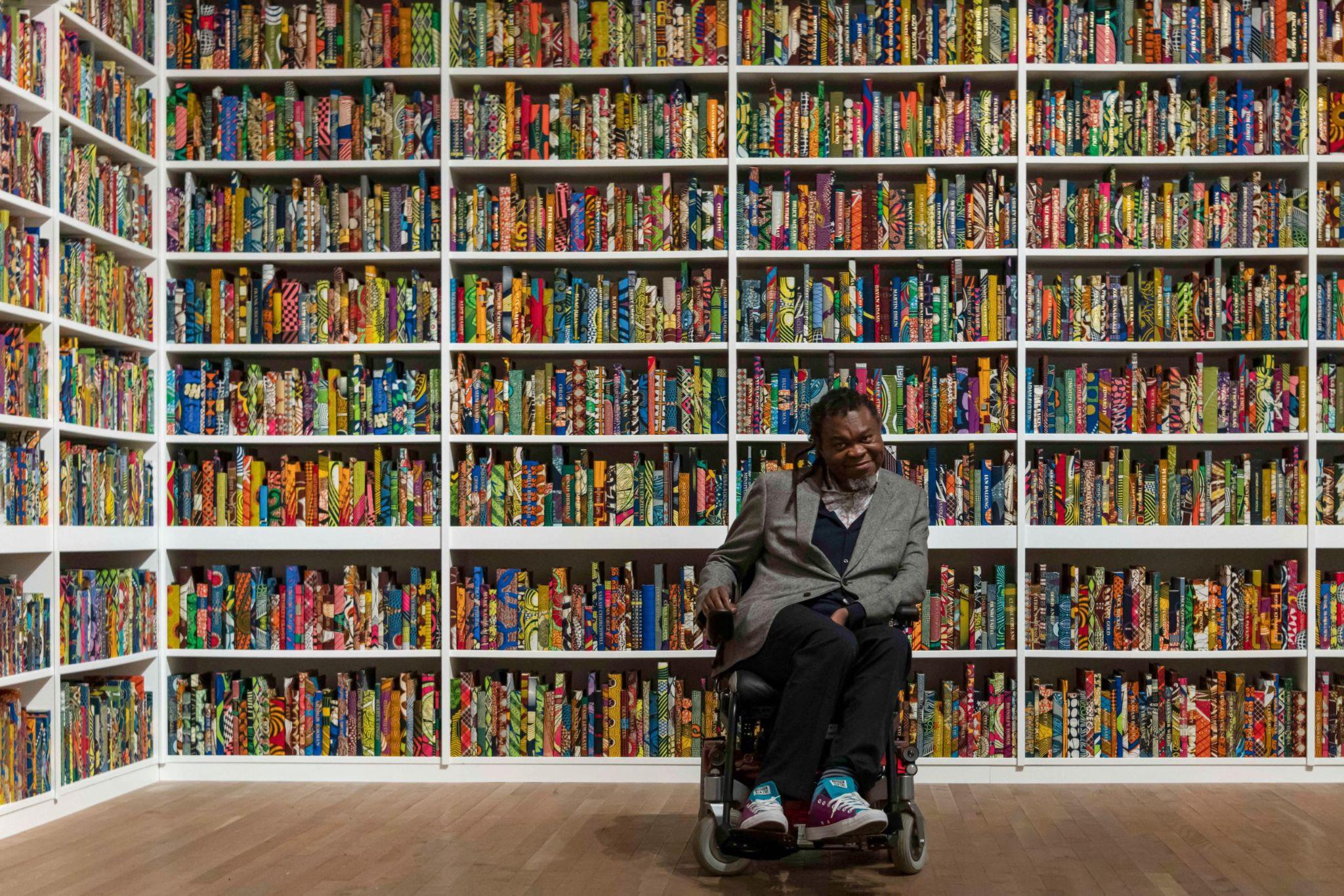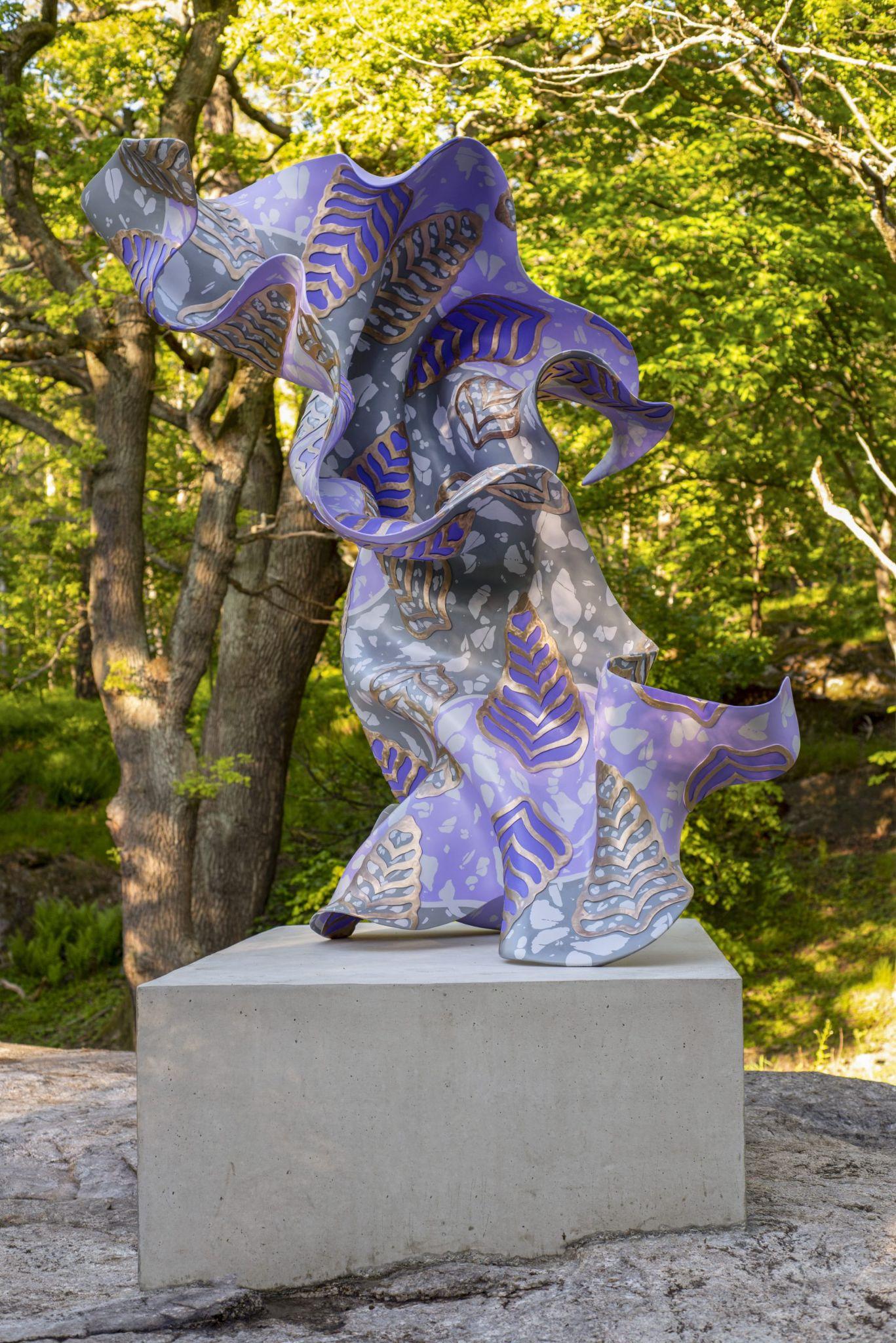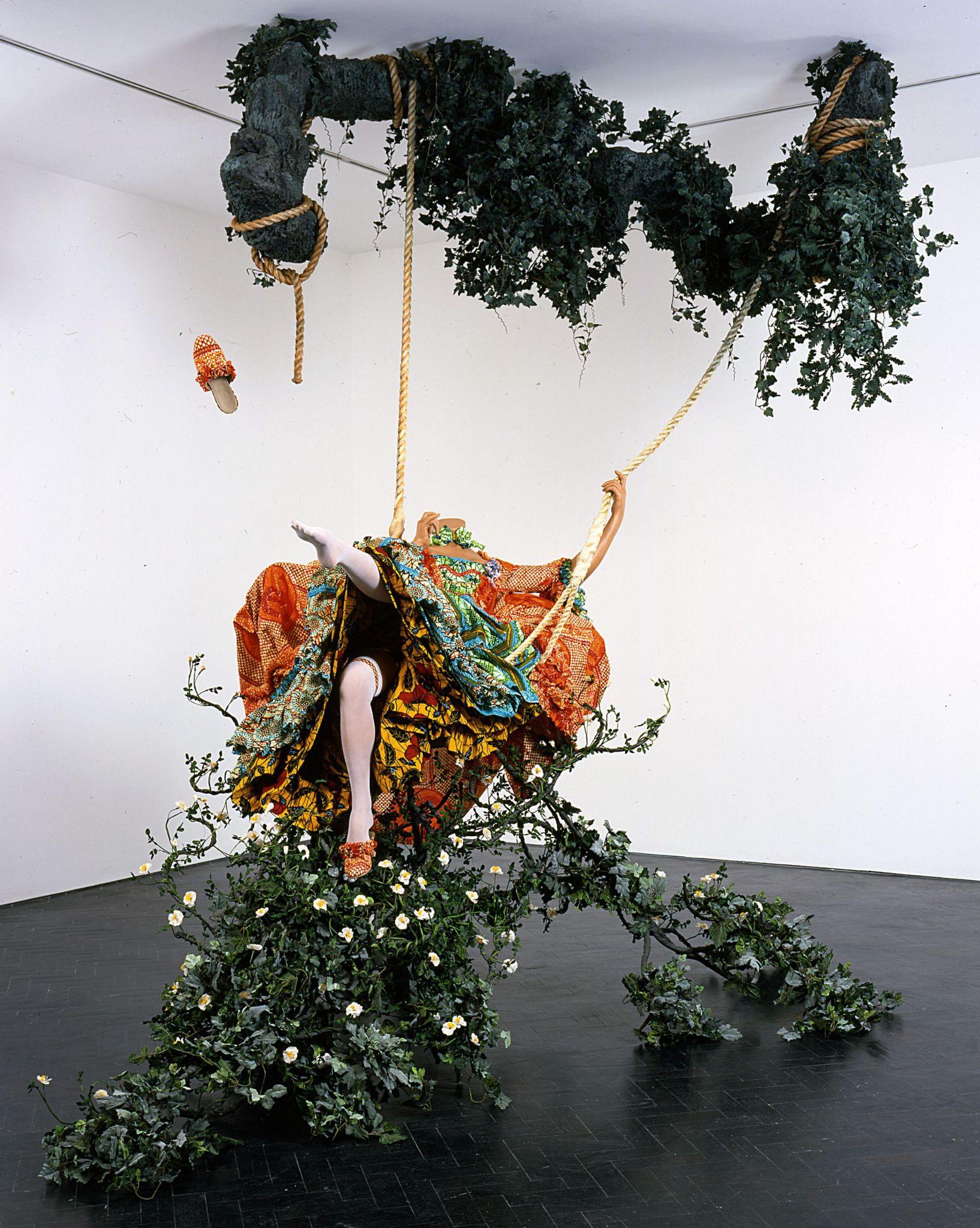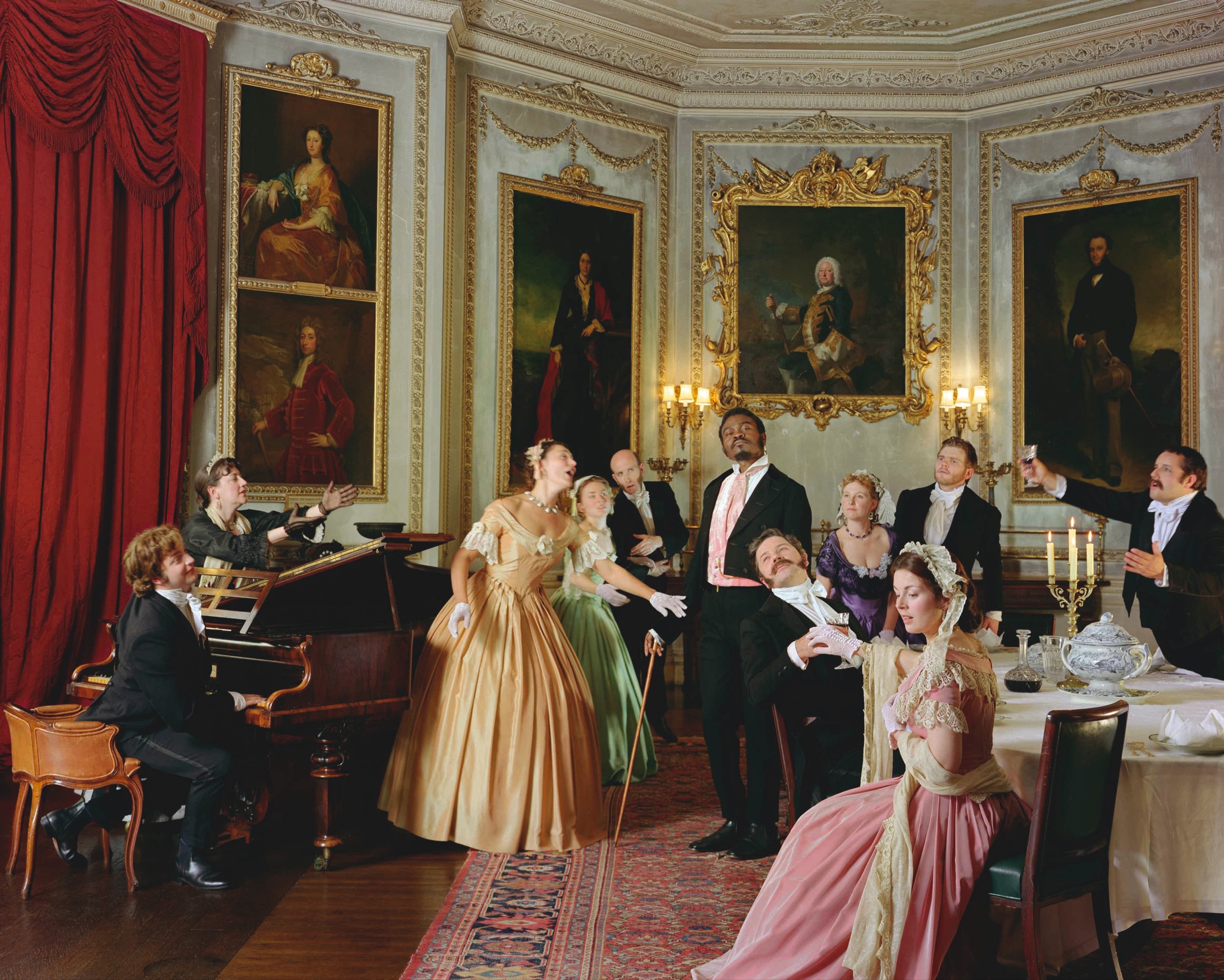Yinka Shonibare Loves a Paradox


Behind Nigerian-British artist Yinka Shonibare CBE RA’s whimsical artistry lies a maverick that loves to challenge the top brass. An award-winning multimedia artist who works with sculpture, paintings, photography, dance performance, and video, Shonibare is perhaps best known for his use of fabric. Shonibare tells me that he hopes to use the medium to “explore the complex relationship between Africa and Europe, particularly the complexities of contemporary hyphenated identities.” This signature element, printed with batik-like technique, has become a metaphor for representation and cross-cultural exchange within his work.
Shonibare’s popular sculptural installation, Mr. And Mrs. Andrews Without Their Heads (1998), typifies his method. Using an interdisciplinary process to engage with elements of the Western canon, Shonibare references Thomas Gainsborough’s 1750 portrait Mr. and Mrs Andrews, both in name and in composition. In Shonibare’s version, the iconic British couple are dressed in the fashion of the 18th century but the fabric has been replaced by “African” batik print. His references to art history and Western literature, represented and re-presented through his decolonial lens, has garnered critical acclaim.
In the late 1990s, Shonibare broke through to a broader audience with his project, Diary of a Victorian Dandy, a homage to Oscar Wilde commissioned by Iniva (Institute of International Visual Artists). Twenty five years after the exhibit was shown on the London underground, Shonibare was commissioned by the permanent sculpture park in Royal Djurgården in Stockholm. In Wind Sculpture in Bronze I, Shonibare transforms his signature textile into a bronze sculpture, painted in a vivid purple hue. On the occasion of the sculpture’s unveiling, I sat down with the artist to discuss his life and work.

Malin Ebbing: You refer to yourself as both a rebel and a dreamer. In what way are these personal characteristics mirrored in your art?
Yinka Shonibare: I have a love-hate relationship with the establishment. Like everyone else, the artist is reflected in their work. Their state of mind, their emotions, will always be on display. There are times when things are quite dark but then they can be dark and quite humorous simultaneously. There are points when I’m talking about upsetting things, but I’m also looking at the flip side. Visually, you can actually represent a number of ideas simultaneously. This is what I enjoy in creating art: that tension and dichotomy of ideas. I like a paradox.

ME: you often reference historical depictions of high society in your work, like in The Swing (After Fragonard), in Tate’s collection — what draws you to this material?
YS: High society and the concept of leisure have always fascinated me. To be in a position to engage in leisure pursuits, you need to be rich and privileged. You need spare time. Money buys you spare time. While the pursuit of leisure may look frivolous, my depiction is a way of engaging with that power; it expresses something more profoundly serious. The accumulation of wealth and power personified in leisure is a product of exploiting others.
ME: The series of prints Diary of a Victorian Dandy, 19.00 from 1998 has taken inspiration from William Hogarth’s The Rake’s Progress — have any old Swedish master paintings similarly intrigued or inspired you?
YS: Art history has provided a rich source of subject matter for me. I’m fascinated by the culture of eighteenth-century Europe and its aristocrats with their love of frivolity and excess. Swedish old masters, including Alexander Roslin and Gustaf Lundberg, depict aristocracy, decadence and wealth in a completely unabashed way in their paintings. These types of depictions inspired me to create works that celebrate excess and decadence while inverting the stereotype of “otherness” — to create an outsider figure who upsets the social order of things.
ME: Wind Sculpture in Bronze I is more abstract. It is the third commission to Princess Estelle’s Sculpture Park — how did you take the other two sculptures into consideration when you were working on this piece?
YS: It’s very powerful to have the opportunity to do public sculpture. It challenges this idea of art as an elite institution. Public art is available to everybody. Politically, it’s something that I believe in. Alice Aycock’s and Elmgreen & Dragset’s sculptures are both great examples of engaging public art — the works each have their own unique presence and voice, while seamlessly connecting to the environment at Princess Estelle’s Sculpture Park. I hope Wind Sculpture in Bronze I does the same.

ME: You were doing an artist residency in Stockholm at IASPIS in 2004 – what is your experience of sharing studios (and ideas) in a setting like this?
YS: My time at IASPIS in 2004 was an incredible learning experience. All the residencies I’ve done have been vital in the development of my ideas and career; I never come back as the same person. The opportunity for artists to have the space and freedom to experiment and collaborate is a necessity, which is why I founded artist residency projects both in London and Lagos. I wanted to create a space for people who want to support each other and connect with creative people who are challenging existing ways of looking at things.
ME: These two residencies are very impressive and much needed. Coming from the generation of Young British Artists — a provocative group — what are your impressions of this new generation of artists?
YS: I think now more than ever young artists’ voices need to be heard, especially those whose identities have been overlooked for so long. For this reason, I have recently opened G.A.S. — Guest Artists Space Foundation in Lagos, Nigeria — a space where the artists can live and work. Just about two hours outside Lagos, we also have a 54-acre farm and farmhouse. We’re doing agriculture, sustainable farming, and a bit of conservation. We want to bring artists from around the world to Africa to facilitate cultural exchange.
ME: Why did you choose to open these sister residencies in separate continents?
YS: I frequently describe myself as a ‘postcolonial hybrid.’ One of the most crucial materials I work with is the brightly colored African’ batik fabric, which serves as a metaphor for migration. This material can be Dutch, Indonesian and African at the same time. For me, the fabrics are a symbol of cross-cultural connections — I use them to explore the complex relationship between Africa and Europe, particularly the complexities of contemporary hyphenated identities.

ME: What are you working on now?
YS: I’m currently creating a series of quilts and masks that further explore the influence of African Art on Modernism for an upcoming solo exhibition at Goodman Gallery in Cape Town. It opens this September. So many modernist artists in the early 20th century were collectors and enthusiasts of the formal language of African artifacts and adapted those in their practices.
I’m also creating works for the Sharjah Biennial which opens in February 2023. This new series titled “Decolonised Structures” recreates seven public statues that shape the cityscape of London. These statues mostly go unnoticed and unquestioned. I hope their reproduction and decontextualization inspire continued debate about the legacy of colonialism in historical education.
You Might Also Like
A Swedish Royal Foundation Presents Work by Yinka Shonibare in Open-Air Sculpture Park
What's Your Reaction?
Writer, Cultbytes Malin Ebbing is a fine art professional and journalist based in Stockholm and Italy. She has a masters' degree in fine and decorative art from Sotheby’s Institute of Art in London. During the two decades that she has been active in the art world, she has worked with auction houses, contemporary art galleries, and art fairs. Her writing focuses on visits to studios and houses of artists and art collectors in Europe and interviews with artists. l igram l

